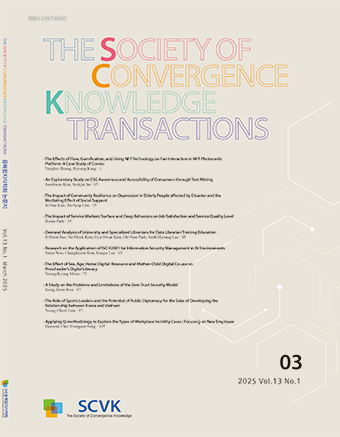Research Article
Abstract
References
Information
교면 유출수는 교량 측구에 설치되는 교량 배수(점배수, 선배수)시설에 의해서 배수된다. 교량 배수시설의 배수불량은 콘크리트 박리, 교량 노후화 및 교량 미관을 해치는 등 다양한 문제가 발생하고 있으므로 집수구 배수시설의 배수효율을 개선한 교량 선배수 시설이 필요하다. 또한 교량 선배수 시설의 적정한 설치를 위해서는 선배수 시스템에 대한 배수능력 분석을 통한 설치 기준의 제시가 필요하다. 본 연구에서는 교량 방호벽 선배수 시설의 단점을 개선하여 모형을 제작하고 설계에 필요한 배수능력을 분석하기 위해 수리실험을 수행하였다. 실험결과 전체 흐름 폭은 52~90cm의 범위로 배수간격 별 도로의 종경사가 커질수록 흐름 폭은 감소하였으며, 전체 차집효율은 1.5~21%의 범위로 도로의 종경사가 증가하거나 배수간격 별 동일한 종경사일 때 유입유량이 커질수록 감소하였다. 또한, 강우강도 및 차집량을 기준으로 배수 간격별 도로 조건에 따른 교량 방호벽 선배수 시설의 최대 설치 길이를 제시하였다. 이는 교량 방호벽 선배수 시설의 설계기준 제시를 위한 기초자료로 활용이 가능할 것으로 판단된다.
Bridge stormwater runoff is drained by a bridge drainage (bridge inlet, linear drainage)facility installed at the side of the bridge. Poor drainage in the drainage facility on the bridge has various problems such as peeling of concrete, deterioration of the bridge, and damage to the aesthetics of the bridge. Therefore, a bridge linear drainage facility with improved drainage efficiency of the catchment drainage facility is needed. In addition, for the proper installation of the bridge linear drainage facility, it is necessary to present the installation standard through the analysis of the drainage capacity of the linear drainage system. In this study, a model was made by improving the shortcomings of the linear drainage facility of the bridge barrier, and a hydraulic experiment was performed to analyze the drainage capacity required for the design. As a result of the experiment, the total flow width was in the range of 52~90cm, and as the longitudinal slope of the road for each drainage interval increased, the flow width decreased. The overall vehicle picking efficiency was in the range of 1.5 to 21%, and the longitudinal slope of the road increased or the same species for each drainage interval. When inclined, it decreased as the inflow flow increased. In addition, the maximum installation length of the bridge protection wall linear drainage facility according to the road conditions for each drainage interval was suggested based on the rainfall intensity and the amount of vehicle collection. It is believed that this can be used as basic data for presenting the design criteria for the linear drainage facility of the bridge barrier.
- "도로 배수시설 설계 및 관리지침", 국토해양부, 2012.
- 이지훈, 최성권, 이현우, 이준희, 박용찬, "교량 배수시설에 대한 설계 및 유지관리", 한국강구조학회지, 제26권 제4호, pp.26-34, 2014.
- 박창호, 이채규, "교량 배수시설 고찰", 서울특별시 도로시설안전포럼, 2018.
- "2011년도 고속도로 설계 실무자료집", 한국도로공사, 2012.
- "국도건설공사 설계실무 요령", 국토교통부, 2016.
- "고속도로건설공사 표준도", 한국도로공사, 2017.
- "도로설계기준", 국토교통부, 2016.
- "하수도시설기준", 환경부, 2011.
- "확률강우량도 개선 및 보완 연구", 국토해양부, 2011.
- Publisher :The Society of Convergence Knowledge
- Publisher(Ko) :융복합지식학회
- Journal Title :The Society of Convergence Knowledge Transactions
- Journal Title(Ko) :융복합지식학회논문지
- Volume : 9
- No :2
- Pages :25-37
- DOI :https://doi.org/10.22716/sckt.2021.9.2.012




 The Society of Convergence Knowledge Transactions
The Society of Convergence Knowledge Transactions







